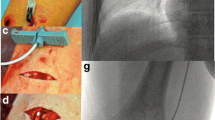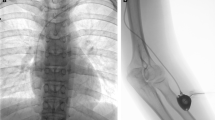Abstract
Purpose
This study aimed to compare patients’ satisfaction and impact on daily life after implantation of totally implantable venous access ports (TIVAP) in the forearm and the chest.
Methods
In this prospective study, 50 patients (mean age, 55.8 ± 15.4 years) received three questionnaires on days 1, 30, and 90 after implantation in the forearm (n = 25) or the chest (n = 25). Knowledge concerning device function, comfort perception, and impact of TIVAP on daily activities were evaluated. Ratings were dichotomized depending on whether statements were agreed with or contradicted. Fisher’s exact test was used to determine differences between the forearm port (FP) and chest port (CP) groups.
Results
There was no significant difference between the two groups with regard to unpleasant feelings (p = 0.09) and discomfort while puncturing (p = 0.06). Main fears in both groups were dysfunction and infection. The possibility of high-pressure injections via the TIVAP was rated important in both groups. More CP patients feared dislocation of their TIVAP during sleep (p < 0.05). CP patients experienced more negative perceptions while driving a car and wearing brassieres (p < 0.05) than FP patients. All patients would recommend their device.
Conclusions
During certain activities, the FP device seems to be favorable, since it causes less discomfort than the CP.

Similar content being viewed by others
References
Kock HJ, Pietsch M, Krause U et al (1998) Implantable vascular access systems: experience in 1500 patients with totally implanted central venous port systems. World J Surg 22:12–16
Teichgraber UK, Kausche S, Nagel SN et al (2011) Outcome analysis in 3,160 implantations of radiologically guided placements of totally implantable central venous port systems. Eur Radiol 21:1224–1232
Goltz JP, Scholl A, Ritter CO et al (2010) Peripherally placed totally implantable venous-access port systems of the forearm: clinical experience in 763 consecutive patients. Cardiovasc Intervent Radiol 33(6):1159–1167
Sakamoto N, Arai Y, Takeuchi Y et al (2010) Ultrasound-guided radiological placement of central venous port via the subclavian vein: a retrospective analysis of 500 cases at a single institute. Cardiovasc Intervent Radiol 33(5):989–999
Kuriakose P, Colon-Otero G, Paz-Fumagalli R (2002) Risk of deep venous thrombosis associated with chest versus arm central venous subcutaneous port catheters: a 5-year single-institution retrospective study. J Vasc Interv Radiol 13:179–184
Goltz JP, Schmid JS, Ritter CO et al (2011) Identification of risk factors for catheter-related thrombosis in patients with totally implantable venous access ports in the forearm. J Vasc Access 13(1):79–85
Lorch H, Zwaan M, Kagel C et al (2001) Central venous access ports placed by interventional radiologists: experience with 125 consecutive patients. Cardiovasc Intervent Radiol 24:180–184
Marcy PY, Chamorey E, Amoretti N et al (2008) A comparison between distal and proximal port device insertion in head and neck cancer. Eur J Surg Oncol 34:1262–1269
Marcy PY, Magne N, Castadot P et al (2005) Radiological and surgical placement of port devices: a 4-year institutional analysis of procedure performance, quality of life and cost in breast cancer patients. Breast Cancer Res Treat 92:61–67
Maurer MH, Beck A, Hamm B et al (2009) Central venous port catheters: evaluation of patients’ satisfaction with implantation under local anesthesia. J Vasc Access 10:27–32
Johansson E, Engervall P, Bjorvell H et al (2009) Patients’ perceptions of having a central venous catheter or a totally implantable subcutaneous port system—results from a randomised study in acute leukaemia. Support Care Cancer 17:137–143
Teichgraber UK, Nagel SN, Kausche S et al (2011) Clinical benefit of power-injectable port systems: a prospective observational study. Eur J Radiol 21(6):1224–1232
Lenhart M, Schatzler S, Manke C et al (2010) Radiological placement of peripheral central venous access ports at the forearm. Technical results and long term outcome in 391 patients. Fortschr Röntgenstr 182(1):20–28
Plumhans C, Mahnken AH, Ocklenburg C et al (2011) Jugular versus subclavian totally implantable access ports: catheter position, complications and intrainterventional pain perception. Eur J Radiol 79(3):338–342
Marcy PY, Figl A, Ianessi A et al (2010) Central and peripheral venous port catheters: evaluation of patients’ satisfaction under local anesthesia. J Vasc Access 11:177–178, author reply 178
Polak JF, Anderson D, Hagspiel K et al (1998) Peripherally inserted central venous catheters: factors affecting patient satisfaction. Am J Roentgenol 170:1609–1611
Nagel SN, Teichgraber UK, Kausche S et al (2011) Satisfaction and quality of life: a survey-based assessment in patients with a totally implantable venous port system. Eur J Cancer Care (Engl) 21:197–204
Conflict of interest
None.
Author information
Authors and Affiliations
Corresponding author
Rights and permissions
About this article
Cite this article
Goltz, J.P., Petritsch, B., Kirchner, J. et al. Percutaneous image-guided implantation of totally implantable venous access ports in the forearm or the chest? A patients’ point of view. Support Care Cancer 21, 505–510 (2013). https://doi.org/10.1007/s00520-012-1544-2
Received:
Accepted:
Published:
Issue Date:
DOI: https://doi.org/10.1007/s00520-012-1544-2




